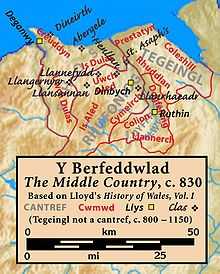Perfeddwlad
Coordinates: 53°17′13″N 3°45′47″W / 53.287°N 3.763°W

Perfeddwlad or Y Berfeddwlad (Welsh for 'Midlands') was a name adopted during the 12th century for the territories in north-east Wales lying between the rivers Conwy and Dee. In the Early Middle Ages, the region as a whole was known as Tegeingl, after the Irish Gaelic tribe Deceangli which inhabited the region since the 1st century BC.[1][2] This region is also known as Gwynedd Is Conwy (Gwynedd below the [River] Conwy), or Lower Gwynedd; in contrast with Gwynedd Uwch Conwy (Gwynedd above the Conwy), or Upper Gwynedd.[3] The region was composed of the cantrefi of Rhos, Rhufoniog, Dyffryn Clwyd and Tegeingl. As the rivalries between Gwynedd, Powys, and England evolved in the High Middle Ages, the region became known in Welsh as the Y Berfeddwlad, the middle country, as it was situated between upper Gwynedd in the west, England to the east, and Powys to the south.
Following the death of Llywelyn Fawr the Perfeddwlad was briefly conquered by Henry III of England in the 1240s but retaken for Gwynedd by Llywelyn ap Gruffudd in the 1250s. It was retaken once more by Edward I in 1277 who kept the two northern cantrefs of Rhos and Tegeingl for the crown but ceded Rhufoniog and Dyffryn Clwyd to Dafydd, Llywelyn's brother who had sided with Edward.
Following Edward's final victory in the years 1282–1283 and the consequent Statute of Rhuddlan in 1284, Rhos and Rhufoniog were combined to form the new lordship of Denbigh and conferred upon Henry de Lacy, earl of Lincoln; Dyffryn Clwyd became the lordship of Ruthin and was granted to Reginald de Grey; and Tegeingl became the lordship of Englefield and the main body of the proto-county of Flint under the aegis of the palatinate of Chester.
Footnotes
- ↑ http://www.historyfiles.co.uk/KingListsBritain/BritainDeceangli.htm
- ↑ By the 1st century AD, the Irish Gaelic tribe the Gangani settled across north Wales, but the Ordovices edged into north-west Wales, separating the Gangani of the Llyn peninsula from the Gangani in the east. The Gangani in the east became known in Latin as Deceangli, or of the Gangani, a name which evolved in Welsh as Tegeingl in the Early Middle Ages.
- ↑ A History of Wales from the Earliest Times
References
- Lloyd, John Edward (1911a), A History of Wales from the Earliest Times to the Edwardian Conquest I (2nd ed.), London: Longmans, Green, and Co (published 1912)
- Lloyd, John Edward (1911b), A History of Wales from the Earliest Times to the Edwardian Conquest II (2nd ed.), London: Longmans, Green, and Co (published 1912)
| ||||||||||||||||||||||||||||||||||||||||||||||||||||